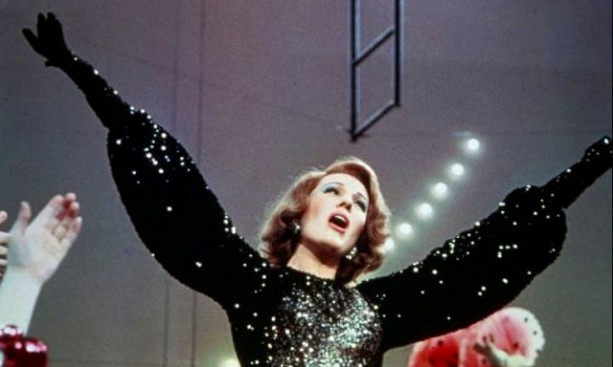
Last November, Peter Guber, chairman of Mandalay Entertainment, invited a few hundred guests to a soiree at his compound in Bel Air. “Many of you know me as a movie guy, or a television guy. I’m certainly a sports guy,” said Guber, who sounds-and looks-a lot like Joe Pesci. “But what I really am is a story guy.” Next to Guber in a row of tall chairs was a panel of celebrity vocalists- Steven Tyler of Aerosmith, Roger Daltry of the Who, and Julie Andrews of The Sound of Music.
“Most recently I realized it was a core tool to really power the whole idea of storytelling,” Guber said, reflecting on the human voice. “That’s how we climbed from the bottom of the food chain to the top of the food chain.” He was wearing a black private jacket over a shirt and tie, with grey flannel slacks, light-grey socks, and what appeared to be alligator tuxedo slippers with laces in place of a bow.
 Guber was hosting the event to drum up support for the nonprofit Institute of Laryngology and Voice Restoration. We’d assembled in a cavernous room in one of three houses on his compound. It had framed movie banners, a built-in display case of trophies, and overstuffed velvet couches. I’d found a seat at a ten-yard-long conference table on which stood a mounted elephant tusk capped with bronze. In a hearth beneath an eight-foot mantle burned a robust fire that was offset by equally robust air-conditioning.
Guber was hosting the event to drum up support for the nonprofit Institute of Laryngology and Voice Restoration. We’d assembled in a cavernous room in one of three houses on his compound. It had framed movie banners, a built-in display case of trophies, and overstuffed velvet couches. I’d found a seat at a ten-yard-long conference table on which stood a mounted elephant tusk capped with bronze. In a hearth beneath an eight-foot mantle burned a robust fire that was offset by equally robust air-conditioning.
Guber passed the microphone to Steven Zeitels, a specialist in laryngeal surgery and voice rehabilitation at Harvard Medical School and Massachusetts General Hospital. Dr. Zeitels had saved the voices of many people in the room. “Now people are possibly more disabled without a voice than without a limb,” Zeitels said. But he was working on a vocal biogel that might be able to repair the human voice–even to restore it.
Steven Tyler, dressed in a black leather ensemble with a silk cheetah-print shirt, took the microphone. “It’s no secret I’ve had problems with substance abuse. I snorted half of Peru,” he said. Some years ago, Tyler found himself hoarse. “I went to Steve and he told me it was a broken blood vessel,” Tyler said. “He lasered my throat, and what a miracle.” Roger Daltry spoke about having trouble singing–until Zeitels had detected pre-cancerous dysplasia and saved Daltrey’s voice in time for a Superbowl appearance.
Julie Andrews, who has been unable to sing since 1997, when a botched throat surgery ruined her vocal cords, spoke about Zeitels’ biogel. “This is the thing that’s so fantastic, and I’m going to go on a bit,” Andrews said. “Let’s say you’ve lost half a vocal cord, and so the cords don’t meet. You’ve got one fairly decent vocal cord and the other half is completely disappeared. When they both come together, they rub and make that terrible sound that everyone has been describing. If, theoretically, you would fill out that second vocal cord with a gel that would meet the other vocal cord, you would stand a chance at having quite a decent voice.”
“So here we all are, hoping for this ‘stuff’–as he always refers to it–this vocal biogel. And it’s this close,” Andrews said. “The FDA has given its approval, but funding is necessary to make all the tests before it can be safely and properly injected into humans.”
Afterwards, Guber and Zeitels joined me for an interview in a neighboring screening room, where playing onscreen earlier had been a loop of a National Geographic Channel documentary about Steven Tyler’s vocal cords that lowered a camera on a voyage into the singer’s vibrating gullet.
I asked Guber how he’d become interested in voice restoration. He said it started when one of his employees had persuaded him to have lunch with Zeitels. Later, on a trip to Boston, Guber had stopped by Zeitel’s office to have his vocal cords checked. “I’d never thought about being hoarse,” he said. “Hoarse was hoarse, you know?”
Zeitels found no serious problem.
“So I was relieved, obviously,” Guber continued. It had made him think about the importance of voice in storytelling. “You metabolize the story very differently from when you just read it,” he said. “So I said, okay, my job is to try to tell the story forward. That’s my job. That’s my mission.”
Guber excused himself to pack for a trip to Mexico, and Zeitels told me more about the biogel. If even three hundred thousand Americans received it–a tiny fraction of the millions who have voice impairment–that would require about a million injections per year. (The biogel needs to be refreshed every few months.) So there must be room for error. “One of the important things about the biomaterial is that it doesn’t have to be perfect,” Zeitels said. “You can get in the wrong spot and you won’t hurt somebody.”
Biomedical engineer Robert Langer, of the Langer Lab at the Massachusetts Institute of Technology, has begun to work with Zeitels on the gel. Financially, the potential is immense. If each injection carries a price tag of a thousand dollars, then, once the venture becomes for-profit, a multi-billion-dollar business has been born. That would give Zeitels the means to pursue further research on treating the larynx.
One of Guber’s staffers appeared and politely shooed us out. Valets brought us our cars, and I tunneled home through the wooded slopes of Bel Air. Illuminated by my headlights in the darkness, the surroundings looked just a little like the inside of Steven Tyler’s throat.
T.A. Frank is editor of Zócalo Public Square.
*Photo courtesy of Movie-Fan.




Send A Letter To the Editors